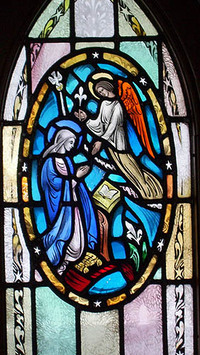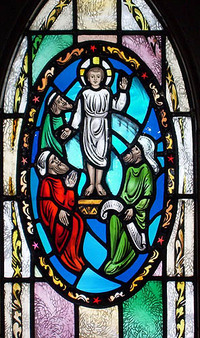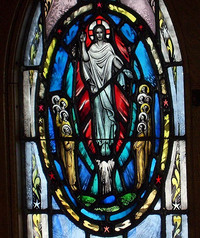MSGC : Featured Windows : Current Window
Featured Windows, June 2006
The Episcopal Church of the Ascension
Building: The Episcopal Church of the Ascension
City: Ontonagon
State: Michigan
The Episcopal Church of the Ascension at Ontonagon traces its roots to 1854, when an Episcopal Church Society was organized in this community on the southern shore of Lake Superior in Michigan's western Upper Peninsula. The church took its name from the Church of the Ascension in New York City, which contributed generously toward the construction of its first building in 1856. After a disastrous fire in 1896 destroyed the Village of Ontonagon, including the church and its rectory, services were held in a "Chapel Car" that was brought in and parked on a siding near the depot. During the late nineteenth and early twentieth centuries, several such Chapel Cars were built by railroad car companies for Baptist, Episcopal and Catholic societies. They were outfitted as small chapels, complete with altars, pump organs, hymnals, and sometimes even stained glass, and were intended for use in remote areas served by railroads, such as mining camps, lumber towns or farming villages. The Chapel Car served as the Church of the Ascension for about two years. When it was no longer needed at Ontonagon, it was moved to a different town along the railroad.
In 1898 a new church was built on the foundation of the first building, but another fire in 1952 destroyed this church also. The present church was erected in 1954 on the site of the original building. Its twelve windows included eleven "temporary" windows made by the Oliver Smith Studios of Bryn Athyn, PA, "of leaded diamond pattern in Glastonbury white, with a ruby red border." The twelfth window was a permanent one made by the Charles J. Connick Associates of Boston, depicting The Ascension in a medallion (bottom right). In the 1980s nine of the "temporary" windows were replaced by other medallion-style windows also made by the Connick studio. Three of the later windows are shown here: The Annunciation, The Boy Jesus in the Temple, and The Crucifixion.
Charles J. Connick (1875-1945) opened his Boston stained glass studio in 1913. Connick and his staff of designers and craftsmen were at the forefront of the revival of the medieval style in stained glass. Their windows featured symbolism in pure color and linear design, and emphasized the relationship between a window's design and its architectural setting, principles set forth in Connick's book, Adventures in Light and Color. Although Connick died in 1945, his studio continued to produce windows in the same medieval style until it closed in 1986, soon after these windows at Ontonagon were made. The extensive Connick Studio Archive is housed at the Boston Public Library. The mission of the Charles J. Connick Stained Glass Foundation, Ltd. is "to promote the true understanding of the glorious medium of color and light and to preserve and perpetuate the Connick tradition of stained glass" through lectures, publications and films.
The Episcopal Church of the Ascension was registered in the Michigan Stained Glass Census by John F. Townsend of Ontonagon.
Images by John F. Townsend
Bibliography:
Show Bibliography"A Short History of the Church of the Ascension, Ontonagon, Michigan." Michigan Stained Glass Census file 06.0011, Michigan State University Museum, East Lansing, Michigan.
"135th Anniversary of the Church of the Ascension." The Ontonagon (Michigan) Herald, 19 July 1989.
Connick, Charles J. Adventures in Light and Color. New York: Random House, 1937.
The Charles J. Connick Stained Glass Foundation, Ltd. "History of the Connick Studio" (1999). http://www.cjconnick.org/
"Episcopal Church Cornerstone Laying Sunday, March 14." The Ontonagon (Michigan) Herald, 13 March 1954.
Taylor, Wilma Rugh and Norman Thomas Taylor. "Chapel Cars of America" (2006). http://www.chapelcars.com/ (MSGC 2006.0011)
Text by Betty MacDowell, Michigan Stained Glass Census, June , 2006.






